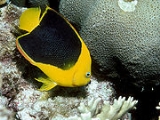
Rock beauty
Encyclopedia
The rock beauty, Holacanthus tricolor, is a species of marine angelfish
of the family
Pomacanthidae.
color can be described as yellow
in the facial region of the body with blue
towards the tail end of the fish. Its tail, however, will retain the yellow coloration. Their pectoral fins and ventral fins are also yellow but their lip
s and the edges of their dorsal fin
s and anal fins are dark blue. An adult Rock Beauthy angelfish can measure up to 10 inches (25.4 cm).
s, jellyfish
, and coral
s, as well as plankton
and algae
. In home aquariums, aquarists have had limited success in providing the Rock Beauty Angelfish a diet of meaty and algae-based foods. Without some amount of sponge in the diet, however, most Rock Beauty Angelfish perish in captivity.
s encompassing the tropical western Atlantic Ocean
down to the northern portion of the Gulf of Mexico
at depths of between 3 and 92 metres.
Marine angelfish
Marine angelfish are perciform fish of the family Pomacanthidae. They are found on shallow reefs in the tropical Atlantic, Indian, and mostly western Pacific oceans. The family contains seven genera and approximately 86 species...
of the family
Family (biology)
In biological classification, family is* a taxonomic rank. Other well-known ranks are life, domain, kingdom, phylum, class, order, genus, and species, with family fitting between order and genus. As for the other well-known ranks, there is the option of an immediately lower rank, indicated by the...
Pomacanthidae.
Description
The adult Rock Beauty angelfish's overall bodyBody
With regard to living things, a body is the physical body of an individual. "Body" often is used in connection with appearance, health issues and death...
color can be described as yellow
Yellow
Yellow is the color evoked by light that stimulates both the L and M cone cells of the retina about equally, with no significant stimulation of the S cone cells. Light with a wavelength of 570–590 nm is yellow, as is light with a suitable mixture of red and green...
in the facial region of the body with blue
Blue
Blue is a colour, the perception of which is evoked by light having a spectrum dominated by energy with a wavelength of roughly 440–490 nm. It is considered one of the additive primary colours. On the HSV Colour Wheel, the complement of blue is yellow; that is, a colour corresponding to an equal...
towards the tail end of the fish. Its tail, however, will retain the yellow coloration. Their pectoral fins and ventral fins are also yellow but their lip
Lip
Lips are a visible body part at the mouth of humans and many animals. Lips are soft, movable, and serve as the opening for food intake and in the articulation of sound and speech...
s and the edges of their dorsal fin
Dorsal fin
A dorsal fin is a fin located on the backs of various unrelated marine and freshwater vertebrates, including most fishes, marine mammals , and the ichthyosaurs...
s and anal fins are dark blue. An adult Rock Beauthy angelfish can measure up to 10 inches (25.4 cm).
Diet
The Rock Beauty Angelfish feeds primarily on sponges. It may also feed on small amounts of tunicateTunicate
Tunicates, also known as urochordates, are members of the subphylum Tunicata, previously known as Urochordata, a group of underwater saclike filter feeders with incurrent and excurrent siphons that is classified within the phylum Chordata. While most tunicates live on the ocean floor, others such...
s, jellyfish
Jellyfish
Jellyfish are free-swimming members of the phylum Cnidaria. Medusa is another word for jellyfish, and refers to any free-swimming jellyfish stages in the phylum Cnidaria...
, and coral
Coral
Corals are marine animals in class Anthozoa of phylum Cnidaria typically living in compact colonies of many identical individual "polyps". The group includes the important reef builders that inhabit tropical oceans and secrete calcium carbonate to form a hard skeleton.A coral "head" is a colony of...
s, as well as plankton
Plankton
Plankton are any drifting organisms that inhabit the pelagic zone of oceans, seas, or bodies of fresh water. That is, plankton are defined by their ecological niche rather than phylogenetic or taxonomic classification...
and algae
Algae
Algae are a large and diverse group of simple, typically autotrophic organisms, ranging from unicellular to multicellular forms, such as the giant kelps that grow to 65 meters in length. They are photosynthetic like plants, and "simple" because their tissues are not organized into the many...
. In home aquariums, aquarists have had limited success in providing the Rock Beauty Angelfish a diet of meaty and algae-based foods. Without some amount of sponge in the diet, however, most Rock Beauty Angelfish perish in captivity.
Distribution
The Rock Beauty Angelfish inhabit reefReef
In nautical terminology, a reef is a rock, sandbar, or other feature lying beneath the surface of the water ....
s encompassing the tropical western Atlantic Ocean
Atlantic Ocean
The Atlantic Ocean is the second-largest of the world's oceanic divisions. With a total area of about , it covers approximately 20% of the Earth's surface and about 26% of its water surface area...
down to the northern portion of the Gulf of Mexico
Gulf of Mexico
The Gulf of Mexico is a partially landlocked ocean basin largely surrounded by the North American continent and the island of Cuba. It is bounded on the northeast, north and northwest by the Gulf Coast of the United States, on the southwest and south by Mexico, and on the southeast by Cuba. In...
at depths of between 3 and 92 metres.

